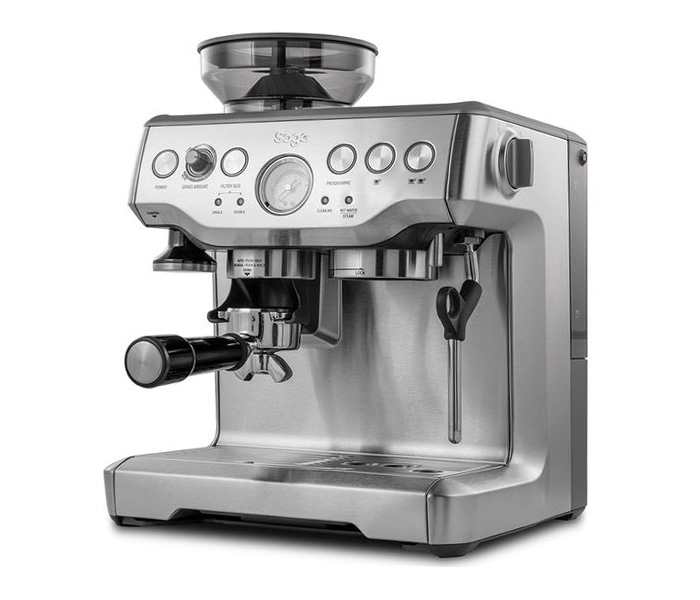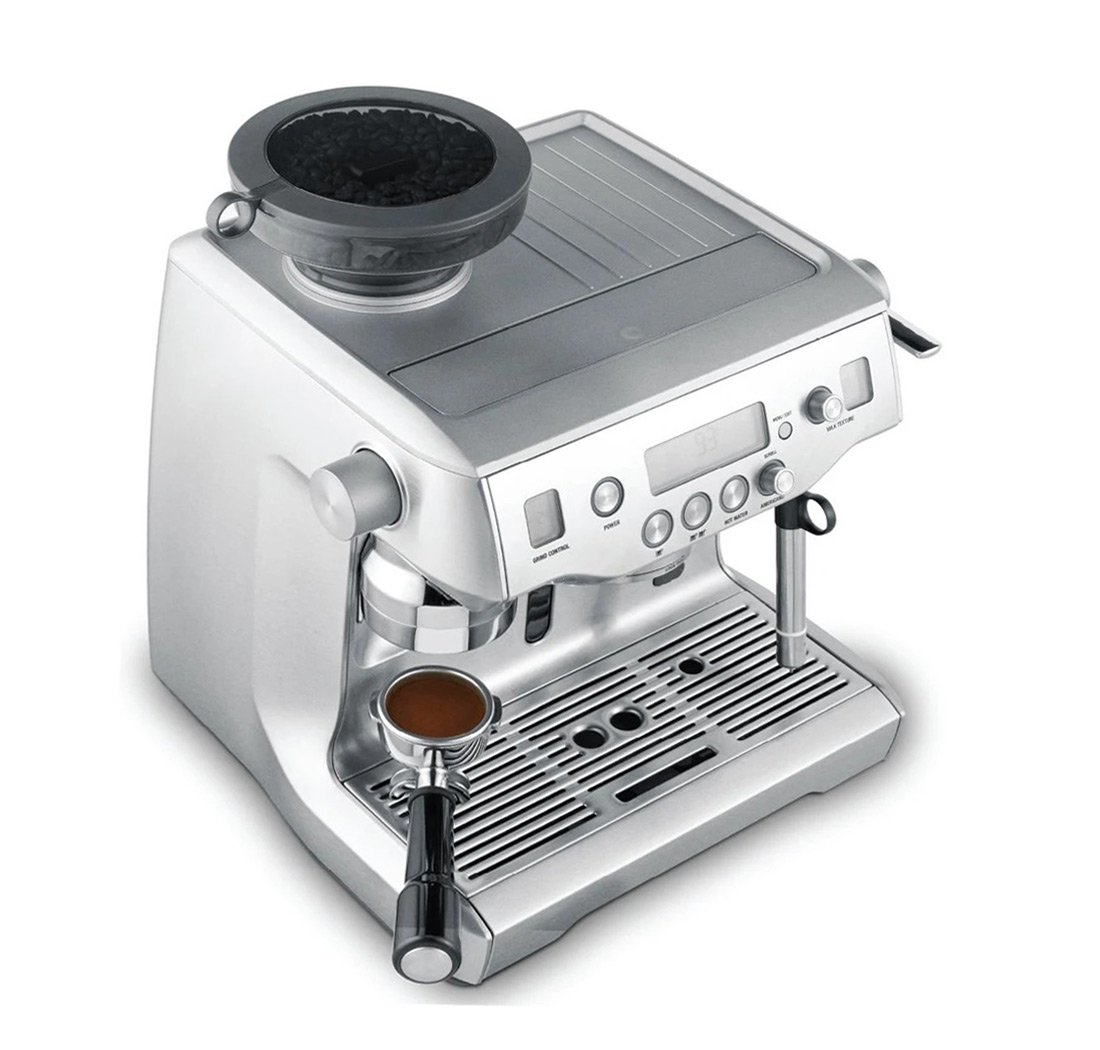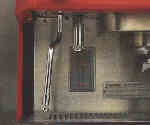Professional Espresso Coffee Brewing
Espresso coffee is prepared by a special extraction method which produces a very concentrated, strong coffee is a short amount of time. Softened water at a temperature of 90-95 °C is forced through finely ground and specially roasted coffee at high pressure (about 9 atmospheres). The contact between the water and the coffee varies from 25 to 35 seconds. The amount of ground coffee per cup varies from 6.5 to 7 grams. The coffee beans must be roasted to a medium to dark colour, and then finely ground. This produces a cup of espresso with a volume of between 10 and 20 millilitres.
There are four factors which ensure a genuine Italian-style cup of espresso:
The following is a brief, technical explanation on how the espresso machine works. This information concerns the average professional equipment. Home espresso gear differs from the specifications below, although the basic principles may be the same.
How the espresso machine works
In auto-fill machines the water is drawn directly from the water supply, and a heat-exchanger brings it up to the right temperature for making espresso. Before the heat-exchanger performs its functions, pressure is generated by a positive-displacement pump, which can be adjusted to achieve a pressure of approximately 9 atmospheres (132 pounds per square inch).
“Infusion time” occurs when heated water is forced under pressure to pass through the grind in order to extract the soluble flavor and aroma substances from the coffee. Under most makes and models of professional machines, this takes about 5 seconds.
First, water under low pressure is released into the space between the diffuser and the filter holder. When this space is full, water is forced through the tamped coffee by the positive displacement vacuum pump at the above pressure. When the brew starts pouring from the spout into the cup, “dispensing time” begins.

Standard espresso machine components
Boiler: a cylindrical reservoir that contains water and steam, which are heated to the temperature required for making espresso. The heat exchanger is a smaller cylinder or cartridge built inside the boiler chamber, through which cold water is drawn from the main water supply. This cold water is therefore heated by the hot water in the boiler. Both heat exchanger and boiler are generally made of copper. A good cup of espresso depends on the correct ratio of water and steam in the boiler.
Level gauge: a glass tube with both top and bottom ends fitted into the boiler. The tube indicates the exact amount of water in the boiler, and must be monitored regularly to assure correct level of water in the boiler chamber. In most modern espresso machines, such level is automatically regulated by auto-fill mechanisms through the use of a probe inside the boiler.
Boiler level, pressure, temperature
 Checking the level of water:
Checking the level of water:
In the case of a manually filled machine, the water in the boiler should be kept at a level corresponding to about the 70% level in the sight glass. When the level drops, a filler tap (operated by a lever or a button) should be used to refill the boiler. In the case of auto-fill machines (also descibed as “self levelling”, and composing the vast majority of units sold today) a probe reads the water level, ensuring that the correct water level is maintained.
Nevertheless, it is always a good idea to check the water level in the boiler, even on auto-fill machines. This could prevent or minimize damages caused by electrical malfunctions, probes losing sensitivity, etc.
Checking temperature and pressure:
To ensure the proper temperature of water dispensed by the dispensing unit (approx. 194 – 203 °F or 90 – 95 °C), the temperature in the boiler must be maintained at a higher level. This is because 25% of the heat is dispersed when the water passes from the heat exchanger (located inside the boiler) to the dispensing unit. In other words, the temperature drops from 248 to 203 °F (120 to 95 °C).
This dispersed heat keeps the metal components at constant temperature, and ensures their proper functioning. If these components are allowed to get too cold, the quality of the brewed coffee will suffer. This means that the boiler must be kept at a constant temperature of around 248 °F and that the pressure gauge should read approximately 14.7 psi. (1 atm.). If the pressure gauge indicates a higher or lower pressure, it should be adjusted by turning the regulator screw on the pressure controller. Loosen it to reduce pressure, tighten it to increase pressure.
Positive Displacement Vacuum Pump: the unit which generates the pressure (approximately 9 atm or 132 psi) required to make espresso. It can be built inside the machine body or mounted under the counter. Pump pressure can normally be adjusted by tightening or loosening the appropriate adjustment screw. To check the pump pressure, leave the full filter basket in place after making a cup of espresso (or replace the filter basket with a “blank” filter, one with no holes) and let the machine run water through it. The pressure level gauge should read approximately 9 atm. (132 psi.). If the pressure is too high or too low, turn the adjustment screw on the pump clockwise to increase it, counter-clockwise to decrease it.

Control elements
Pressure regulator (pressure-stat): a device for regulating the pressure in the boiler and keeping it within predetermined settings. The pressure-stat powers the heating element inside the boiler on and off as necessary. Its settings can be adjusted by turning the appropriate screw.
Pressure gauges: Normally two instruments which measure and indicate both: a) the pressure in the boiler and, b) the pressure generated by the positive displacement pump.
Safety valve: a calibrated and sealed valve which discharges steam from the boiler whenever steam pressure exceeds a pre-set limit.
Operating elements
 Water and steam spouts: for heating and preparing drinks. Tip: Never draw hot water from the boiler to prepare drinks such as teas. The water is not fresh and may be contaminated with backflushed milk residues from the steam wands.
Water and steam spouts: for heating and preparing drinks. Tip: Never draw hot water from the boiler to prepare drinks such as teas. The water is not fresh and may be contaminated with backflushed milk residues from the steam wands.
Filters: round metal strainer baskets which hold pre-measured amounts of ground coffee (1 and 2-cup models exist), and are held into the filter holders. Coffee liquid produced by pressurized water passes through the holes in the filters and into the cup. Both filters and their holders will last much longer if you remember, at the end of each day, to soak them in water overnight. Never use soap to clean these parts. To check them for scale, hold them against a source of light. If the holes are badly plugged or not of uniform size, replace the baskets with new ones.
Diffusers: mesh screens that ensure the even distribution of hot water over the tamped coffee in the filter. They should be changed or cleaned regularly. A typical symptom of worn out or partially blocked diffusers is hollows left in the coffee grounds in the filter holder after extraction.
Gaskets: cylindrical seals, which maintain a watertight seal between the filter and the dispenser unit.
Water softener: a unit containing cationic resins which neutralize substances in the water that cause scaly deposits. The result is purified, softened water. The unit is situated behind the displacement pump, between water line and espresso machine. It needs to be replenished on a regular basis with ordinary coarse salt, which dissolves in the unit and “regenerates” the resins, according to the following schedule:
| Daily coffee usage | Replenish frequency |
| 3.3 lbs (1.5 kg) | Once a month |
| 6.6 lbs (3.0 kg) | Every 2 weeks |
| 13.2 lbs (6.0 kg) | Once a week |
